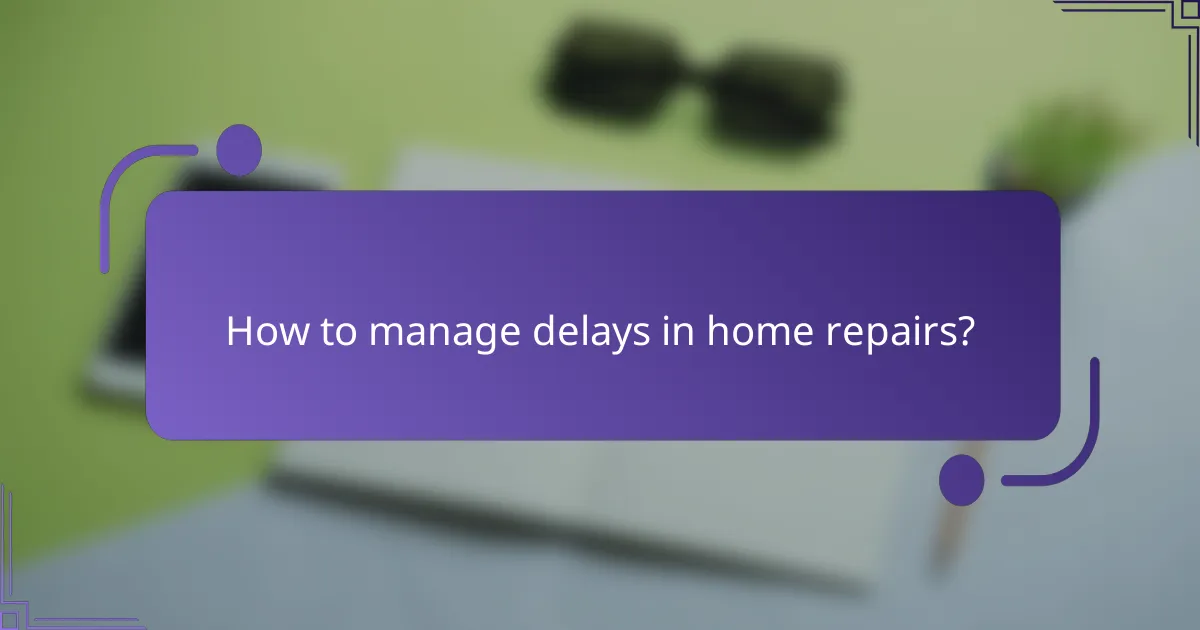Understanding home repair timelines is crucial for homeowners looking to manage their expectations effectively. Factors such as project complexity, contractor availability, and material supply can significantly influence how long repairs will take. By establishing clear deadlines and milestones with your contractor, you can ensure both parties are aligned on the timeline and prepared for any potential delays.

What are typical home repair timelines in Los Angeles?
Home repair timelines in Los Angeles can vary significantly based on the type of project, complexity, and contractor availability. Generally, homeowners should expect to wait anywhere from a few days to several weeks for most repairs, depending on the scope of work involved.
Bathroom remodel timelines
Bathroom remodels in Los Angeles typically take between two to four weeks to complete. The timeline can be influenced by factors such as the size of the bathroom, the extent of the changes, and the availability of materials. For instance, a simple cosmetic update may be finished in under two weeks, while a complete overhaul could extend beyond four weeks.
When planning a bathroom remodel, ensure you communicate clearly with your contractor about your expectations and any specific design elements you want. Delays can occur if custom fixtures or tiles are needed, so factor in additional time for sourcing these items.
Kitchen renovation timelines
Kitchen renovations usually require a longer commitment, with timelines ranging from four to eight weeks. The complexity of the renovation, including structural changes or high-end finishes, can significantly affect the duration. A minor update, like replacing countertops or cabinets, may take about four weeks, while a full remodel could push the timeline to eight weeks or more.
To avoid potential delays, establish a clear schedule with your contractor and discuss any potential supply chain issues that could impact material availability. Regular check-ins can help keep the project on track.
Roof repair timelines
Roof repairs in Los Angeles can typically be completed within a few days to a week, depending on the extent of the damage and the type of roofing material used. Minor repairs, such as fixing leaks or replacing a few shingles, may only take a day or two, while more extensive work, like a full roof replacement, could take up to a week.
It’s crucial to assess the weather conditions when planning roof repairs, as rain or extreme heat can delay work. Always ensure your contractor has a clear plan for addressing any unforeseen issues that may arise during the repair process.

How to communicate timelines with your contractor?
To effectively communicate timelines with your contractor, establish clear deadlines and milestones from the start. This ensures both parties have aligned expectations regarding project completion and any potential delays.
Setting clear expectations
Setting clear expectations involves discussing specific project phases and their respective timelines. Start by outlining the overall project scope and breaking it down into manageable tasks, each with its own deadline.
For example, if you are renovating a kitchen, you might set timelines for demolition, plumbing, electrical work, and cabinetry installation. This clarity helps prevent misunderstandings and keeps the project on track.
Regular check-ins throughout the project can help maintain these expectations. Schedule weekly updates to discuss progress and any adjustments needed to the timeline.
Using timeline charts
Using timeline charts can visually represent the project schedule, making it easier for both you and your contractor to understand the flow of work. Gantt charts are particularly effective, as they display tasks along a timeline, showing start and end dates.
Consider creating a simple chart that includes key milestones, such as when materials will arrive or when inspections are scheduled. This can help you track progress and identify any potential delays early on.
When using timeline charts, ensure they are updated regularly to reflect any changes in the project schedule. This keeps everyone informed and helps manage expectations effectively.

What factors affect home repair timelines?
Home repair timelines can be influenced by several key factors, including the scope of work, material availability, and weather conditions. Understanding these elements helps set realistic expectations and improves communication with your contractor.
Scope of work
The scope of work outlines the specific tasks and repairs required for your home project. A larger or more complex project will naturally take longer than a simple repair, so clearly defining the scope is crucial.
For instance, a full kitchen remodel will involve more time than replacing a single faucet. Discussing the details with your contractor can help establish a timeline that reflects the work involved.
Material availability
Material availability significantly impacts repair timelines, as delays in sourcing materials can halt progress. Popular materials may be readily available, while specialty items could take weeks or even months to arrive.
It’s wise to confirm the availability of essential materials before starting the project. Consider discussing alternatives with your contractor to avoid delays if specific items are not in stock.
Weather conditions
Weather conditions can affect outdoor repairs and renovations, potentially causing delays. Rain, snow, or extreme temperatures can halt work and extend timelines unexpectedly.
For outdoor projects, it’s beneficial to monitor the weather forecast and plan accordingly. Your contractor should also have contingency plans for adverse weather to minimize disruptions and keep the project on track.

How to manage delays in home repairs?
Managing delays in home repairs involves clear communication with your contractor and proactive planning. Establishing regular updates and having contingency plans can help mitigate the impact of unexpected setbacks.
Regular check-ins
Regular check-ins with your contractor are crucial for staying informed about the progress of your home repairs. Schedule weekly or bi-weekly meetings to discuss timelines, challenges, and any changes to the project scope.
During these check-ins, ask specific questions about the status of work, materials, and labor availability. This proactive approach helps identify potential delays early and allows for timely adjustments to the schedule.
Contingency planning
Contingency planning is essential for addressing potential delays in home repairs. Discuss with your contractor what factors could lead to setbacks, such as weather conditions or supply chain issues, and develop alternative strategies to keep the project on track.
Consider setting aside a budget of around 10-20% of the total project cost for unexpected expenses. This financial buffer can help you accommodate unforeseen delays without significant disruption to your overall plans.

What are common contractor communication pitfalls?
Common contractor communication pitfalls include a lack of updates and an unclear project scope. These issues can lead to misunderstandings, delays, and dissatisfaction with the overall project outcome.
Lack of updates
A lack of updates from your contractor can create uncertainty about project progress and timelines. Regular communication is essential to keep you informed and aligned with the work being done.
To avoid this pitfall, establish a communication schedule at the project’s start. Agree on how often you will receive updates—weekly or bi-weekly—and through which channels, such as email or phone calls.
Additionally, ask for specific milestones to be reported on, which can help you gauge if the project is on track. If updates are not forthcoming, proactively reach out to your contractor to request information.
Unclear project scope
An unclear project scope can lead to misunderstandings about what work is included and what is not. This can result in unexpected costs and delays, as both parties may have different expectations.
To prevent scope-related issues, create a detailed project plan that outlines all tasks, materials, and timelines. Make sure both you and the contractor agree on this plan before work begins.
Consider using visual aids, such as drawings or diagrams, to clarify complex aspects of the project. Regularly revisit the scope during progress meetings to ensure everyone remains aligned and to address any changes promptly.

How to choose the right contractor in Los Angeles?
Choosing the right contractor in Los Angeles involves assessing their qualifications, experience, and reputation. It’s essential to ensure they are licensed, insured, and have a solid track record in the local market.
Checking references
When selecting a contractor, checking references is crucial. Ask for a list of previous clients and reach out to them to inquire about their experiences. Pay attention to aspects like communication, timeliness, and the quality of work.
Consider asking specific questions such as whether the project was completed on budget and if any issues arose during the process. This feedback can provide valuable insights into the contractor’s reliability and professionalism.
Reviewing past projects
Reviewing a contractor’s past projects helps you gauge their style and quality of work. Request a portfolio that showcases completed jobs similar to your project. Look for consistency in craftsmanship and attention to detail.
Additionally, visiting completed projects in person can offer a clearer picture of the contractor’s capabilities. If possible, talk to homeowners about their satisfaction with the work and any challenges they faced during the project.

What are the legal considerations for home repair timelines?
Legal considerations for home repair timelines primarily involve contract stipulations and local regulations. Homeowners should ensure that timelines are clearly defined in contracts to avoid disputes and understand their rights regarding delays or changes.
Contractual Obligations
Contractual obligations dictate the expected timelines for project completion. A well-drafted contract should specify start and end dates, milestones, and penalties for delays. Ensure that both parties agree on these terms to prevent misunderstandings.
For example, if a contractor fails to meet a deadline, the contract may allow for financial penalties or the option to terminate the agreement. This clarity helps protect the homeowner’s interests.
Local Regulations
Local regulations can affect home repair timelines, as certain permits or inspections may be required before work can commence. Familiarize yourself with local building codes and zoning laws to avoid unexpected delays.
In some areas, permits can take several weeks to obtain, which can impact the overall timeline. Always check with local authorities to ensure compliance and timely progress on your project.
Communication and Documentation
Effective communication with your contractor is crucial for managing timelines. Regular updates and documentation of progress can help identify potential delays early on. Keep a written record of all communications regarding timelines and changes.
Establish a schedule for check-ins, and don’t hesitate to ask for clarification on any delays. This proactive approach can help maintain accountability and ensure that both parties are aligned on expectations.
